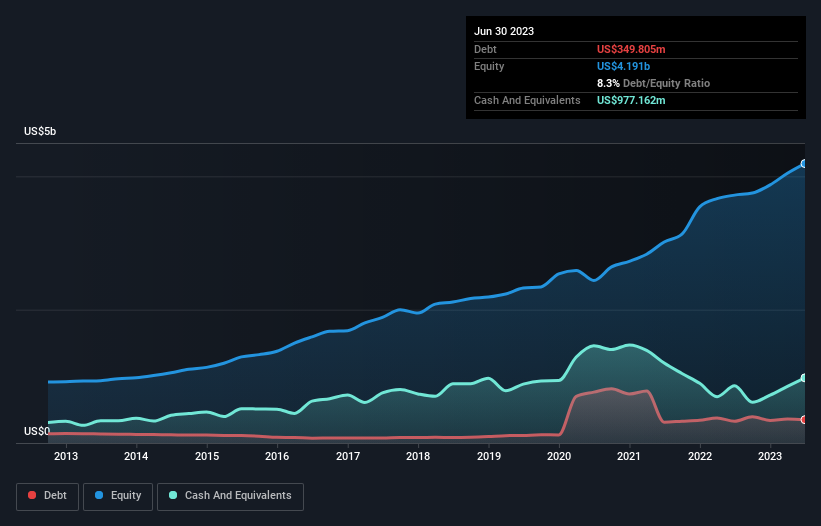
David Iben put it well when he said, 'Volatility is not a risk we care about. What we care about is avoiding the permanent loss of capital.' So it might be obvious that you need to consider debt, when you think about how risky any given stock is, because too much debt can sink a company. As with many other companies Skechers U.S.A., Inc. (NYSE:SKX) makes use of debt. But the real question is whether this debt is making the company risky.
Why Does Debt Bring Risk?
Debt and other liabilities become risky for a business when it cannot easily fulfill those obligations, either with free cash flow or by raising capital at an attractive price. If things get really bad, the lenders can take control of the business. However, a more common (but still painful) scenario is that it has to raise new equity capital at a low price, thus permanently diluting shareholders. Of course, debt can be an important tool in businesses, particularly capital heavy businesses. The first step when considering a company's debt levels is to consider its cash and debt together.
See our latest analysis for Skechers U.S.A
What Is Skechers U.S.A's Net Debt?
You can click the graphic below for the historical numbers, but it shows that as of June 2023 Skechers U.S.A had US$349.8m of debt, an increase on US$326.7m, over one year. However, its balance sheet shows it holds US$977.2m in cash, so it actually has US$627.4m net cash.

A Look At Skechers U.S.A's Liabilities
We can see from the most recent balance sheet that Skechers U.S.A had liabilities of US$1.48b falling due within a year, and liabilities of US$1.44b due beyond that. On the other hand, it had cash of US$977.2m and US$1.01b worth of receivables due within a year. So it has liabilities totalling US$929.5m more than its cash and near-term receivables, combined.
Given Skechers U.S.A has a market capitalization of US$8.68b, it's hard to believe these liabilities pose much threat. Having said that, it's clear that we should continue to monitor its balance sheet, lest it change for the worse. Despite its noteworthy liabilities, Skechers U.S.A boasts net cash, so it's fair to say it does not have a heavy debt load!
And we also note warmly that Skechers U.S.A grew its EBIT by 16% last year, making its debt load easier to handle. When analysing debt levels, the balance sheet is the obvious place to start. But it is future earnings, more than anything, that will determine Skechers U.S.A's ability to maintain a healthy balance sheet going forward. So if you're focused on the future you can check out this free report showing analyst profit forecasts.
But our final consideration is also important, because a company cannot pay debt with paper profits; it needs cold hard cash. Skechers U.S.A may have net cash on the balance sheet, but it is still interesting to look at how well the business converts its earnings before interest and tax (EBIT) to free cash flow, because that will influence both its need for, and its capacity to manage debt. Over the last three years, Skechers U.S.A reported free cash flow worth 9.0% of its EBIT, which is really quite low. For us, cash conversion that low sparks a little paranoia about is ability to extinguish debt.
Summing Up
Although Skechers U.S.A's balance sheet isn't particularly strong, due to the total liabilities, it is clearly positive to see that it has net cash of US$627.4m. And we liked the look of last year's 16% year-on-year EBIT growth. So we don't have any problem with Skechers U.S.A's use of debt. There's no doubt that we learn most about debt from the balance sheet. But ultimately, every company can contain risks that exist outside of the balance sheet. To that end, you should be aware of the 3 warning signs we've spotted with Skechers U.S.A .
At the end of the day, it's often better to focus on companies that are free from net debt. You can access our special list of such companies (all with a track record of profit growth). It's free.
New: Manage All Your Stock Portfolios in One Place
We've created the ultimate portfolio companion for stock investors, and it's free.
• Connect an unlimited number of Portfolios and see your total in one currency
• Be alerted to new Warning Signs or Risks via email or mobile
• Track the Fair Value of your stocks
Have feedback on this article? Concerned about the content? Get in touch with us directly. Alternatively, email editorial-team (at) simplywallst.com.
This article by Simply Wall St is general in nature. We provide commentary based on historical data and analyst forecasts only using an unbiased methodology and our articles are not intended to be financial advice. It does not constitute a recommendation to buy or sell any stock, and does not take account of your objectives, or your financial situation. We aim to bring you long-term focused analysis driven by fundamental data. Note that our analysis may not factor in the latest price-sensitive company announcements or qualitative material. Simply Wall St has no position in any stocks mentioned.
About NYSE:SKX
Skechers U.S.A
Designs, develops, markets, and distributes footwear for men, women, and children worldwide.
Very undervalued with proven track record.


